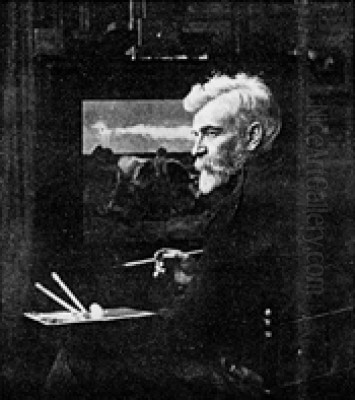
Julien Dupré (1851-1910) stands as a significant figure in late 19th-century French art, celebrated for his evocative and naturalistic portrayals of rural life. A prominent member of the second generation of Realist painters, Dupré dedicated his career to capturing the landscapes and labourers of the French countryside, particularly focusing on the dignity and dynamism of peasant work. His paintings, characterized by vibrant colour, sensitivity to light, and energetic compositions, offer a compelling window into the agrarian world transitioning under the pressures of modernity. Born and trained in Paris, he achieved considerable success during his lifetime, exhibiting regularly at the prestigious Paris Salon and gaining recognition both in France and internationally, especially in the United States.
Early Life and Artistic Formation
Julien Dupré was born on March 18, 1851, in Paris, within the historic Marais district. His family background was rooted in craftsmanship, specifically the jewelry trade, with his father being a jeweler. Initially, the young Dupré was expected to follow a path related to the family's artisanal milieu, and he was apprenticed to a lace-making or embroidery business. However, his innate talent and passion for drawing soon became apparent, steering him towards a career in the fine arts.
His artistic aspirations were temporarily interrupted by the outbreak of the Franco-Prussian War in 1870. Like many young Frenchmen of his generation, Dupré served in the military during the conflict. He remained in service until the war concluded, returning to civilian life around 1873. This period of national turmoil and military experience likely shaped his worldview and perhaps deepened his appreciation for the enduring rhythms of rural life, which would become central to his art.
Upon completing his military service, Dupré fully committed to his artistic education. He enrolled at the École des Arts Décoratifs in Paris, where he honed his drawing skills. Seeking further instruction, he later entered the esteemed École des Beaux-Arts. There, he studied under notable academic painters Isidore Pils (1813-1875) and Henri Lehmann (1814-1882). These instructors provided him with a solid foundation in academic technique, emphasizing draughtsmanship and composition, which would underpin his later, more naturalistic works.
Debut and Rise to Prominence
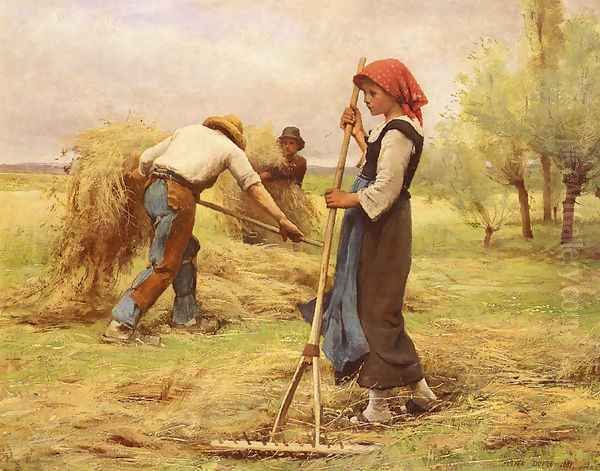
Dupré's professional journey began in earnest in 1876 when he made his debut at the highly influential Paris Salon. He exhibited his painting La Moisson en Picardie (Harvest in Picardy), signaling his thematic interest in agricultural scenes from the outset. The Salon was the premier venue for artists to gain exposure and establish their reputations, and Dupré's regular participation throughout his career was crucial to his success.
Recognition followed relatively swiftly. His skill in depicting rural labour with both accuracy and a sense of vitality resonated with critics and the public. In 1880, he was awarded a third-class medal at the Salon. Just a year later, in 1881, he received a second-class medal for his work La récolte des foins (The Hay Harvest), a testament to his growing mastery and the appeal of his subject matter.
Dupré's reputation extended beyond French borders. His works found a receptive audience in the United States, where depictions of European peasant life were popular among collectors. As early as 1886, his painting Harvesters at Rest was exhibited at the Metropolitan Museum of Art in New York, marking his American debut. The following year, another work, La moisson, reportedly fetched a significant price (,000-,000) at a New York auction, indicating his established market value overseas. His international standing was further cemented by participation in events like the World's Columbian Exposition in Chicago.
The culmination of his official recognition came with two major honours. At the Exposition Universelle (World's Fair) held in Paris in 1889, a landmark event celebrating French culture and industry, Dupré was awarded a prestigious Gold Medal. This was followed in 1892 by his appointment as a Chevalier of the Légion d'Honneur (Legion of Honour), France's highest order of merit, acknowledging his significant contributions to French art.
Artistic Style and Influences
Julien Dupré forged a distinctive style rooted in the Realist and Naturalist movements that dominated French art in the latter half of the 19th century. While clearly influenced by the Barbizon School's commitment to landscape and rural themes, Dupré developed his own approach, characterized by a brighter palette, more dynamic compositions, and a particular focus on the human figure in action within the landscape.
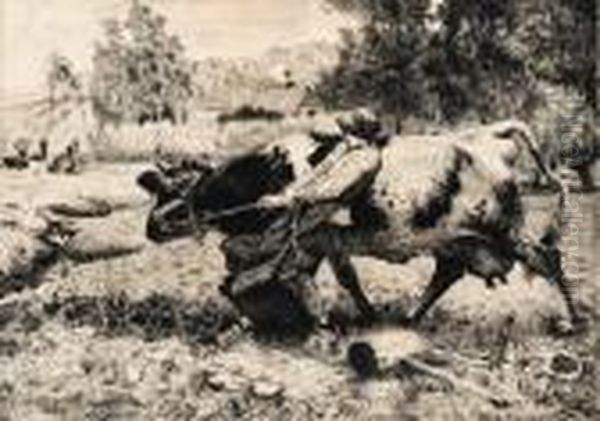
His work is often compared to that of Jean-François Millet (1814-1875) and Jules Breton (1827-1906), leading figures of the first generation of peasant painters. Like Millet, Dupré depicted the hardships and nobility of rural labour. Like Breton, he often imbued his peasant figures, particularly women, with a certain heroic or idealized grace. However, Dupré's style is generally considered more energetic and less sombre than Millet's, and perhaps more overtly naturalistic in its rendering of light and atmosphere than Breton's more poetic interpretations.
The influence of the Barbizon painters, such as Théodore Rousseau (1812-1867) and Camille Corot (1796-1875), is evident in Dupré's sensitive treatment of landscape and natural light. He shared their practice of observing nature directly, often painting outdoors or making studies in the regions he depicted, such as Normandy and Picardy. Other Barbizon figures like Narcisse Virgilio Díaz de la Peña (1807-1876) and Charles-François Daubigny (1817-1878) also contributed to the artistic environment that shaped Dupré.
Dupré's handling of light and colour shows an awareness of Impressionist techniques, although he remained fundamentally a Realist painter. His use of high-saturation colours and his attention to the effects of sunlight create a sense of immediacy and vibrancy. Some sources also suggest influences from earlier masters, including the landscapes of the 17th-century Dutch Golden Age painters and the English landscapist John Constable (1776-1837), whose work had significantly impacted French landscape painting earlier in the century. An interest in the structured compositions of Nicolas Poussin (1594-1665) has also been noted, though the Barbizon and Realist connections are more central to his style.
Themes and Subject Matter
The heart of Dupré's oeuvre lies in his depiction of French agrarian life during a period of significant social and economic change. He consistently focused on the activities of the agricultural calendar: sowing, haymaking, harvesting, gleaning, and tending livestock. His paintings celebrate the enduring connection between the peasant and the land, portraying labour not just as toil but as a fundamental, often dignified, human activity.
Female figures feature prominently in Dupré's work. He often depicted women engaged in strenuous farm tasks – pitching hay, binding sheaves, milking cows, or gleaning leftover grain after the harvest. These women are typically portrayed as strong, capable, and central to the rural economy. While grounded in realistic observation, these figures sometimes possess an idealized, almost heroic quality, embodying resilience and vitality. This focus aligns with a broader 19th-century artistic interest in the figure of the female peasant.
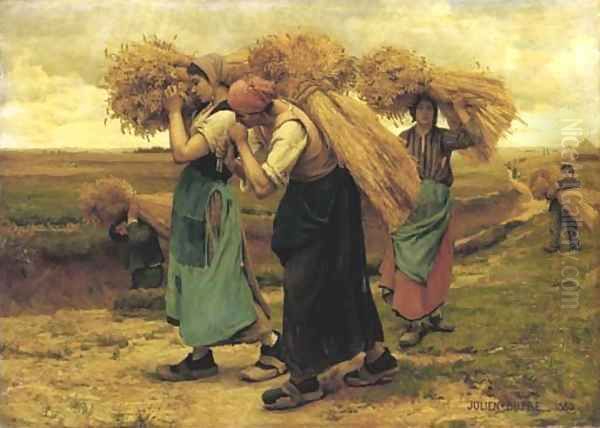
Animals, particularly cows, are also recurring subjects in Dupré's paintings. He rendered them with anatomical accuracy and a keen sense of their presence within the landscape, often showing them grazing peacefully in pastures or being led home by milkmaids. Works like Au Pâturage (In the Pasture) highlight this aspect of his work, showcasing his skill in animal portraiture and his understanding of the pastoral harmony between humans, animals, and nature.
While most of his work focuses on traditional rural scenes, one notable painting, Le Ballon (The Balloon) from 1886, introduces an element of modernity. It depicts peasants in a field pausing their work to gaze up at a hot air balloon drifting across the sky. This juxtaposition of timeless agricultural labour with a symbol of technological progress offers a subtle commentary on the changing world encroaching upon the traditional countryside. It reflects the broader societal shifts occurring in France during the late 19th century.
Key Works
Several paintings stand out as emblematic of Julien Dupré's artistic vision and thematic concerns:
La Moisson en Picardie (Harvest in Picardy, 1876): His Salon debut piece, establishing his focus on large-scale depictions of agricultural labour.
Les Glaneuses (The Gleaners, 1880): Revisiting a theme famously treated by Millet, Dupré portrays women gathering leftover grain. His version emphasizes the physical effort and movement of the figures under the bright sunlight, reflecting his more dynamic approach.
La Recolte Des Foins (The Hay Harvest, 1881): This award-winning painting captures the communal effort of haymaking, a recurring and favourite theme for Dupré. It showcases his ability to orchestrate complex compositions with multiple figures in vigorous action, bathed in the warm light of a summer day. Variations on this theme, often titled Haying Scene, Cutting Hay, or The Mower(s), appear throughout his career.
Au Pâturage (In the Pasture): Representative of his pastoral scenes, often featuring a solitary female figure tending cows in a tranquil landscape. These works highlight his skill in rendering animals and creating serene, atmospheric settings. Dans la Prairie (In the Meadow) explores similar themes.
Le Ballon (The Balloon, 1886): A unique work depicting peasants observing a hot air balloon. It contrasts traditional rural life with modern technology, offering a glimpse into the era's fascination with invention and its impact on the countryside.
Harvesters at Rest (1886): Exhibited early in the US, this work likely depicted labourers taking a break, showcasing Dupré's ability to capture moments of both toil and repose within the agricultural cycle.
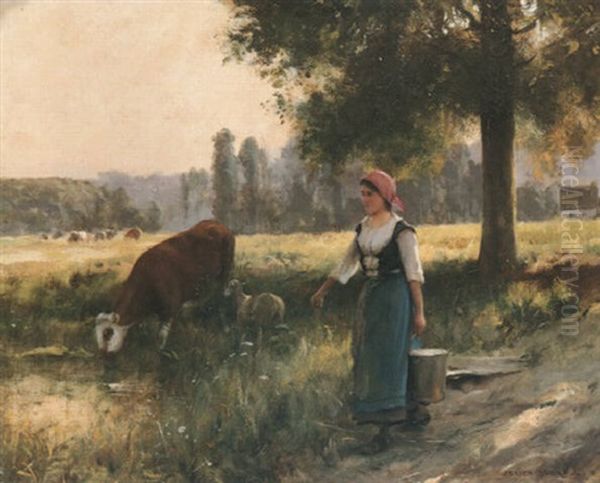
The Milkmaid (c. 1900): A later work focusing on another common rural task. It likely exemplifies his mature style, combining realistic detail with a sensitive portrayal of the interaction between the woman and the animal.
These works, among many others, demonstrate Dupré's consistent engagement with the realities and rhythms of French rural life, rendered with technical skill and a distinctively energetic naturalism.
Connections and Contemporaries
Julien Dupré did not work in isolation. He was part of a vibrant artistic community in Paris and was connected, through influence or association, with several key figures of his time. His relationship with the Barbizon School was significant, not just stylistically but also personally. Sources mention a close early collaboration with Théodore Rousseau, suggesting shared artistic explorations, although they reportedly drifted apart later in their careers.
His art clearly dialogues with that of Jean-François Millet and Jules Breton, the established masters of peasant painting. Dupré absorbed their lessons but adapted them to his own sensibility, creating works that felt both traditional and fresh to contemporary audiences.
A fascinating connection exists with Vincent van Gogh (1853-1890). Van Gogh expressed admiration for Dupré's work in his letters to his brother Theo, specifically recommending Dupré's paintings. This indicates that Dupré's naturalistic style and rural themes resonated with artists exploring similar subjects, even those developing radically different post-impressionist styles. The source material also suggests Dupré's naturalism may have inspired Impressionists like Claude Monet (1840-1926), perhaps through his focus on capturing light and scenes of contemporary rural life, contributing to the artistic climate from which Impressionism emerged.
Dupré is sometimes confused with Jules Dupré (1811-1889), an older and prominent Barbizon landscape painter. Despite the similar names and shared interest in landscape, research indicates they were not related, though the confusion persisted even among contemporaries like Van Gogh, who initially thought Julien might be Jules's nephew.
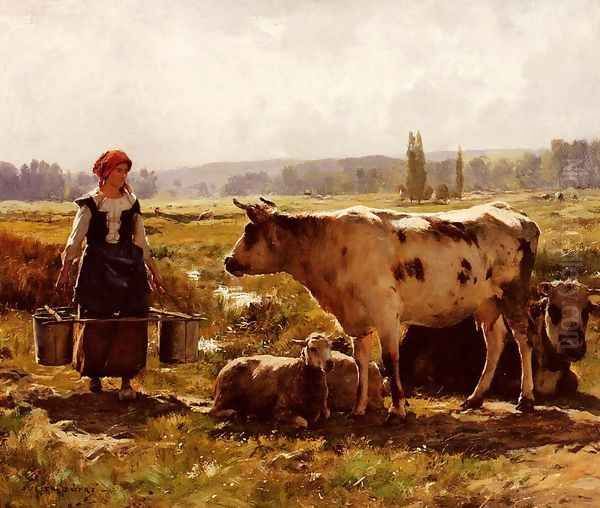
As a successful Salon painter, Julien Dupré would have been aware of, and exhibited alongside, other major figures of the academic and realist traditions, such as Léon Bonnat (1833-1922) or William-Adolphe Bouguereau (1825-1905), even though his style and subject matter differed significantly from their more polished, often historical or mythological, works. His teachers, Isidore Pils and Henri Lehmann, also connect him to the established academic system of the time. His engagement with English landscape painting links him indirectly to John Constable.
Later Life, Death, and Legacy
Julien Dupré continued to paint prolifically throughout the later years of his career, remaining faithful to his chosen themes of French rural life. He maintained a solid reputation, supported by his earlier Salon successes and honours, and continued to exhibit his work. Despite his achievements, he seems to have maintained a relatively low public profile compared to some of his more flamboyant contemporaries.
His life was cut short by illness. Dupré suffered from cancer in his later years and passed away in April 1910 (some sources state March 1910) at the age of 59. His death marked the end of a career dedicated to the honest and vigorous depiction of the French peasant.
In the decades following his death, Dupré's work, like that of many other successful 19th-century Realist and Naturalist painters, experienced a period of relative neglect. The rise of Modernism, with its emphasis on abstraction and avant-garde experimentation, shifted critical and curatorial attention away from representational art focused on traditional themes. Critics sometimes found his work perhaps too pleasant or lacking the profound social commentary or emotional depth seen in Millet, or the radical innovation of the Impressionists and Post-Impressionists.
However, recent decades have witnessed a renewed appreciation for 19th-century academic and realist art. Dupré's paintings are increasingly recognized for their technical skill, their vibrant depiction of light and movement, and their value as historical documents of a rapidly changing rural world. His works are held in numerous museum collections across France, the United States, and elsewhere, including the Musée d'Orsay in Paris, the Museum of Fine Arts, Boston, the Saint Louis Art Museum, and many others.
Efforts like the Virtual Catalogue Raisonné project initiated by Rehs Galleries in New York aim to comprehensively document Dupré's oeuvre and solidify his place in art history. Contemporary evaluations acknowledge his position as a key figure bridging the gap between the Barbizon school and later developments, praising his ability to infuse traditional rural scenes with energy and a palpable sense of life.
Conclusion
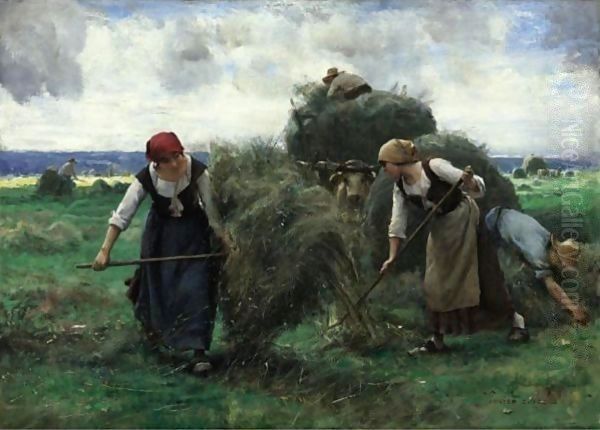
Julien Dupré's legacy rests on his sensitive and technically accomplished portrayal of French rural life in the late 19th century. As a leading Naturalist painter, he captured the dignity of peasant labour and the beauty of the French countryside with a characteristic vibrancy and attention to light. Influenced by the Barbizon School and contemporaries like Millet and Breton, he developed a distinct style that earned him considerable acclaim during his lifetime. While overshadowed for a time by modernist movements, his work is now increasingly valued for its artistic merit and its insightful depiction of a pivotal era in French social history. Through his dynamic compositions and empathetic portrayal of labourers, particularly women, Dupré created an enduring testament to the enduring rhythms of agrarian life.